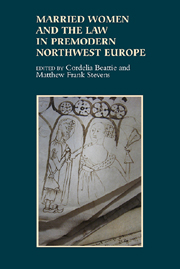Book contents
- Frontmatter
- Contents
- Figures and Tables
- Contributors
- Introduction: Uncovering Married Women
- 1 Inheritance, Property and Marriage in Medieval Norway
- 2 Spousal Disputes, the Marital Property System, and the Law in Later Medieval Sweden
- 3 When Two Worlds Collide: Marriage and the Law in Medieval Ireland
- 4 Married Women, Crime and the Courts in Late Medieval Wales
- 5 Peasant Women, Agency and Status in Mid-Thirteenth- to Late Fourteenth-Century England: Some Reconsiderations
- 6 London's Married Women, Debt Litigation and Coverture in the Court of Common Pleas
- 7 Married Women, Contracts and Coverture in Late Medieval England
- 8 Property, Family and Partnership: Married Women and Legal Capability in Late Medieval Ghent
- 9 ‘For His Interest’? Women, Debt and Coverture in Early Modern Scotland
- 10 The Worth of Married Women in the English Church Courts, c.1550–1730
- 11 Married Women, Work and the Law: Evidence from Early Modern Germany
- Index
9 - ‘For His Interest’? Women, Debt and Coverture in Early Modern Scotland
Published online by Cambridge University Press: 05 July 2013
- Frontmatter
- Contents
- Figures and Tables
- Contributors
- Introduction: Uncovering Married Women
- 1 Inheritance, Property and Marriage in Medieval Norway
- 2 Spousal Disputes, the Marital Property System, and the Law in Later Medieval Sweden
- 3 When Two Worlds Collide: Marriage and the Law in Medieval Ireland
- 4 Married Women, Crime and the Courts in Late Medieval Wales
- 5 Peasant Women, Agency and Status in Mid-Thirteenth- to Late Fourteenth-Century England: Some Reconsiderations
- 6 London's Married Women, Debt Litigation and Coverture in the Court of Common Pleas
- 7 Married Women, Contracts and Coverture in Late Medieval England
- 8 Property, Family and Partnership: Married Women and Legal Capability in Late Medieval Ghent
- 9 ‘For His Interest’? Women, Debt and Coverture in Early Modern Scotland
- 10 The Worth of Married Women in the English Church Courts, c.1550–1730
- 11 Married Women, Work and the Law: Evidence from Early Modern Germany
- Index
Summary
On 24 February 1629, George Reid and Isabel King, his wife, were ordered by the Burgh Court of Edinburgh to pay £6 10s. to James Graham and his wife, Agnes Johnston, for cloth. While this case is largely unremarkable - in that it is just one of hundreds of debt cases entered into the burghs Register of Decreets for 1629 - it does highlight an important aspect of the networks of debt and credit that existed in Edinburgh in the early modern period. Specifically, it highlights the role that wives played in these networks, for while Isabel's and Agnes's husbands are both named in the case and presumably appeared with their wives in court, the reason for the debt is identified as being for the complete payment of six quarters of lint bought by Isabel from Agnes a year and a half prior to the two couples' appearance in court. Theoretically, upon her marriage, a wife's legal identity was subsumed by her husband's, and she could no longer contract debts without her husband's permission. Yet, in this case we have one wife acting as a creditor and another acting as a debtor without the explicit permission of their husbands, although tacit permission can be assumed as both husbands are named in the case with their wives. Nor is this case exceptional when considering the tens of thousands of debt cases that were entered into the court records of Edinburgh, Haddington and Linlithgow between 1560 and 1640. Rather, numerous examples exist in the debt litigation for all three towns that show wives as active participants in the economy of debt and credit in early modern Scotland.
- Type
- Chapter
- Information
- Married Women and the Law in Premodern Northwest Europe , pp. 173 - 190Publisher: Boydell & BrewerPrint publication year: 2013



